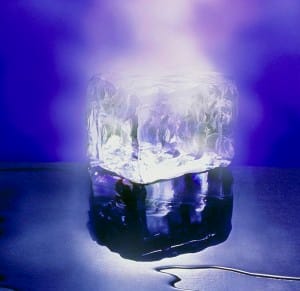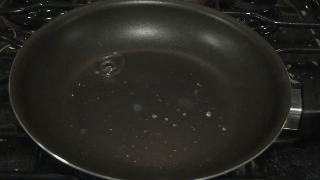leidenfrost effect | 2016-04-06

we need it to live, we sit by it and swim in it on our vacations, and we use it in multiple forms for multiple purposes. for example, when we sit by water on vacation and our drink gets warm, we drop some water into the glass to cool it down — solid water. then, we dive into the liquid water. then, after a hard day in the sun, in our five-star hotel, we take advantage of the steam room — gaseous water. the only difference between these states of water is the temperature.
just like any other substance, when the atoms/molecules that form water lose enough energy, they slow down and stop moving. in reverse, if they gain enough energy, they start to zoom around so much that they fly apart. we call this cooling and heating but it’s simply gaining or losing energy.
sometimes, however, things gain or lose energy really quickly. it’s called sublimation when frozen water sudden jumps to gaseous form. it’s called deposition when water vapour jumps to solid form.
but the coolest thing happens when you take liquid water and toss it on a surface that is heated to over 200 degrees celcius (water’s boiling point is 100 degrees celcius — i.e. when it switches from liquid to gas). when the water droplets land on that hot surface, lets use a pot on a stove as an example, they don’t immediately burn off and leave a mark on the pan as would happen at lower temperatures. instead, what happens is the Leidenfrost effect.
in order to protect itselves from immediately boiling off, a water droplet that is introduced on to a surface far above its boiling point will form a protective vapour barrier between itself and the hot surface. the vapour is made when the droplet hits the surface and the part of it closest to the heat immediately turns to gas. this vapour creates a tiny pocket under the rest of the water in the droplet that prevents it from actually touching the surface and, so, it forms into a little glob of water and skitters across the surface. if you grab the handle of the pan and move it around, you can even get the water to circle around the edge of the pan at high speeds, which looks really cool.
this effect was first described by Johann Gottlob Leidenfrost in 1756 and can be observed in many different substances, albeit at different temperatures, depending on each substances boiling point. for example, some people have demonstrated the effect by dipping their fingers into cold water and then dipping their wet finger tips into molten lead, using the effect to avoid injury. similarly, you can pour liquid nitrogen into your mouth and then spit it out with tremendous steamy, cloudy effect thanks to the Leidenfrost (just don’t swallow it, lest you surely die).
 |
| fingers in molten lead |
 |
| spit liquid nitrogen |
some more details here and here
so far on the Leidenfrost effect






